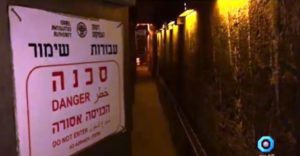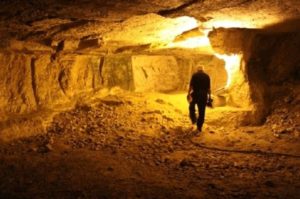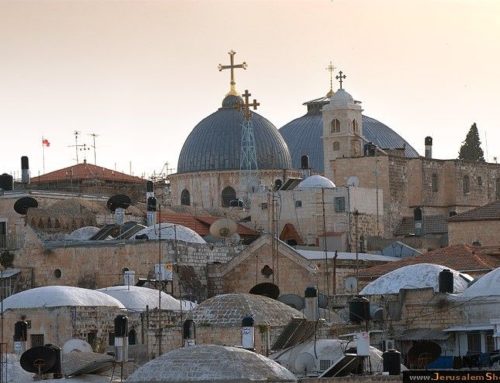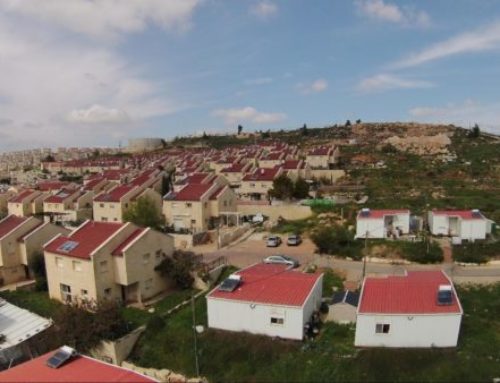When Israel occupied the eastern part of the city of Jerusalem, including the Old City, in 1967, it started implementing its plan of changing the Arab character of the city to reflect a more Jewish view. Many excavation operations have been carried out, especially in the southern and western parts of Al-Aqsa Plaza, [1]and many tunnels have been dug under the walls of the Old City. Furthermore, many buildings and facilities.[2] have been destroyed, many of which without valid explanation. Israeli reasoning and methodology will be explored in this article
.
Background
In the years of 1967-1968, Israeli occupation of the Old City of Jerusalem began. With the occupation came the extensive excavations in the southern and western parts of Al-Aqsa Plaza.[3] Some of these excavations went deep enough to uncover Roman and early Islamic remains from as far back as the Middle Ages. [4]
Dozens of excavations were uncovered by Jerusalemites under and around the Old City. The Western Tunnel, also known as the Jebusite or Al-Buraq Tunnel, is the most famous of the excavations,[5] because of its history and its measurements, as it is 450m long with a height of 2.5m.[6] Israel started working on this tunnel, located under the Ottoman Court and next to the Western Wall, in 1970.[7] In 1987 a water channel was uncovered in that tunnel, and Israelis tried to continue digging. They had to stop. however, because of Palestinian resistance. Still, in 1996, Israel secretly continued working on the tunnel, which led to violent clashes with the Palestinians. This resulted in the murder of 88 Palestinian youth.[8] In addition to the aforementioned, many other tunnels were dug or are currently being dug under and around the Old City. Some of the tunnels almost reached the Dome of the Rock, such as the Qattanin Gate Tunnel in 1981, however they were stopped by the Palestinian Endowment Authority, who filled the tunnels with concrete.[9]

Reasons Behind the Excavations
The excavations are carried out as part of the continuous search for remains of the First and Second Temples that were allegedly built where the Dome of the Rock stands today..[10] Others argue that the main reason Israel carries out excavations under and around Al-Aqsa is its desire to ultimately cause the destruction of both the mosque and the Islamic and historical buildings around it by weakening their bases, using the story of the temples only as a guise.
.[11]
Israel is planning to build a religious city under Al-Aqsa Plaza, which would be used for tourism purposes, while it prepares to rebuild the Third Temple.[12] This plan was disclosed to the public by Israel itself back during the Camp David negotiations with the Arab leaders in 2000. The Israeli negotiation team expressed its interest in the area beneath Al-Aqsa, stating that they would leave the upper level for the Muslims.[13]
Overall, Israel has a number of reasons as to why they carry out the aforementioned excavations. Some are historical, such as focusing on finding pieces of Jewish history in the region, while some of them are religious, such as rebuilding the holy temples. Finally, some are political, as Israelis aim to change the cultural and religious character of the Arab and Muslim parts of the Holy City.[14]
Effects of the Excavations on the City
Excavations resulted in the cracks in the infrastructure of historical buildings, which led to the collapse of portions of said buildings. These issues even affected Al-Aqsa Mosque and its facilities, so much so that experts in the field warn that an earthquake with a magnitude of five would lead to the complete destruction of the mosque. [15] In addition, the excavations work as a form of practical control over the occupied land by aiding in judaizing the city, establishing more settlements, and replacing the Islamic and Arab history with a Jewish one.[16]

Destruction plan around Al-Aqsa
One might think that the excavations are limited to the many tunnels under and around Al-Aqsa. This is only part of the scary truth, however. Even earlier than 1967, Israel had been destroying the Arab buildings in the city. One of the earliest landmarks to be destroyed was the Moroccan Quarter in the Old City..[17] A total of 135 Palestinian homes were destroyed, resulting in the expulsion of 650 Palestinian Muslims.[18]
The Israeli authorities are also changing the historical and religious character of the city by modernizing the city in such a way that presents Israel as the sovereign owner of the city. For example, a historical religious school in the southern part of the city has been updated and is now being used as a training center for Israeli border patrol..[19]
After Israel carries out their excavation operations, Palestinians attempt to repair the foundations that have been damaged in the process. Israel denies the Palestinian Endowment Authority the right to make these repairs, maintaining that the damage is irreparable and that the buildings are going to collapse despite any repairs..[20]This has happened repeatedly in the past, and the Israeli refusal to allow the restoration of Al-Marwani Mosque in 2004 and the Al-Mughrabie Gate in 2007 are examples.[21]
Israeli Denial
Israel, under international pressure and condemnation, has been denying the existence of any excavations.[22] while refusing to allow any international committee under the UN to enter and investigate .[23] This denial is refuted by the facts on the ground, which are recorded, photographed and shared by Jerusalemites and international activists who gain access to the tunnels. In the past, especially in the 1970s, Israel was not ashamed to declare its real intentions in carrying out its “sacred mission.” This was reported by Yedioth Ahronoth, one of Israel’s official news papers.[24] The report held that the government’s intention to uncover the Wailing Wall was a “historical and sacred mission” that would also “diminish [the] buildings around it.” This was reassured by Moshe Dayan, Minister of Defense in 1971.[25]
The Reaction of the International Community
When the excavations began in the 1960s and 70s, the international community opposed the Israeli excavations and considered them a crime for which Israel had to be punished. Kathleen Kenyon, who was on an archaeological mission sponsored by the British government to Jerusalem, considered the Israeli excavations in the Old City a major crime and called upon the international community to stop the systematic destruction of the character of the city.[26]
The Reaction of the United Nations
The three main bodies of the United Nations (the Security Council, the General Assembly, and UNESCO) have been condemning the Israeli archeological excavations in the Old City ever since the excavations started in 1967, and repeatedly requested Israel to desist from altering the features of Jerusalem’s historical and cultural character. The UN also repeatedly called on Israel to preserve the historical and religious heritage of Jerusalem..[27]The UN Security Council addressed the issue in many of its resolutions,[28]in which it considered the Israeli measures, including the excavations that intended to change the status of Jerusalem void and null.[29]
UN General Assembly in many of its resolutions [30] condemned the Israeli transformation of Jerusalem’s historical, cultural and religious sites in an attempt to change the city’s status and identity.[31]
UNESCO has long expressed its condemnation of the Israeli actions in Jerusalem, especially those which aim at changing the status of the city.[32] UNESCO even went as far as listing Jerusalem on its Endangered World Heritage List. Many resolutions were passed [33] in which the UNESCO expressed its concerns and condemnation of the archeological works of Israel including the excavations under and around Al-Aqsa compound.[34]Moreover, UNESCO requested the appointment of a permanent representative of the UN to be stationed in East Jerusalem[35] After many futile attempts by UNESCO to ask Israel to stop its illegal actions in Jerusalem, including the excavations, UNESCO decided to cut its financial aid to Israel. This had some negative impacts, however, as the US responded by cutting aid to UNESCO to pressure them into easing up on Israel.[36]
[1] Habib Ghanem, Jerusalem: a History and a Cause (Lebanon: Dar Al-Manhel, 2002), p 129
[2] entire neighborhood has been destroyed in Jerusalem, for example the Morrocan neighborhood next to the Western Wall, was destroyed entirely in 1967-1968 to build a parking lot for Jewish worshippers visiting the wall.
[3] “Archeological Excavations under Jerusalem,” at https://www.aljazeera.net/news/alquds/2016/8/13/الحفريات-الإسرائيلية-أسفل-القدس-والأقصى posted August 14, 2016.
[4] Id
[5] Excavations under Al-Aqsa: a continuing attempts to Judaizing the City,” at https://www.alaraby.co.uk/politics/2018/11/11/حفريات-الأنفاق-أسفل-المسجد-الأقصى-محاولات-فرض-التهويد-مستمرة posted November 12, 2018
[6] https://www.aljazeera.net/news/alquds/2016/8/13/الحفريات-الإسرائيلية-أسفل-القدس-والأقصى
[7] https://www.aljazeera.net/news/alquds/2016/8/13/الحفريات-الإسرائيلية-أسفل-القدس-والأقصى
[8] https://www.alaraby.co.uk/politics/2018/11/11/حفريات-الأنفاق-أسفل-المسجد-الأقصى-محاولات-فرض-التهويد-مستمرة
[9] Id
[10] Riad Yassin and Amjad Al-Fa’ouri, the Political and Cultural History of Jerusalem (Jordan: Dar Wael, 2012),
p 113 and Henry Cattan, Jerusalem (London: Saqi Books, 2000), p75
[11] Ghanem, Jerusalem, p129
[12] Yaseen and Fa’ouri, the Political and Cultural History, p113
[13] Id 116
[14] https://www.aljazeera.net/news/alquds/2016/8/13/الحفريات-الإسرائيلية-أسفل-القدس-والأقصى
[15] “The Israeli Excavations in Jerusalem: where to?,” at https://www.dailysabah.com/arabic/arab-world/2018/02/27/إلى-أين-وصلت-حفريات-إسرائيل-تحت-المسجد-الأقصى؟ posted February 27, 2018
[16] https://www.aljazeera.net/news/alquds/2016/8/13/الحفريات-الإسرائيلية-أسفل-القدس-والأقصى
[17] Cattan, Jerusalem, p 75
[18] Id p 75
[19] Yaseen and Fa’ouri, the Political and Cultural History p114
[20]Id 116
[21] Id
[22] https://www.dailysabah.com/arabic/arab-world/2018/02/27/ إلى-أين-وصلت-حفريات-إسرائيل-تحت-المسجد-الأقصى؟
[23] Id
[24] Ghanem, Jerusalem, p 130-131
[25] Id
[26] Id 130-131
[27] Cattan, Jerusalem, p 76
[28] especially 252 of 1968, 267 of 1969, 271 of 1969, 298 of 1971, 476 of 1980, and 1073 of 1996, which were passed specifically on the western tunnel riots
[29]29 “UN Resolutions on Jerusalem,” at https://www.aljazeera.com/focus/2010/03/201032584536420174.htm
[30] such as 2253 of 1967 and 36/15 of 1981
[31] Id
[32]Ghanem, Jerusalem, p 132
[33]some of the recent resolutions of the UNESCO on the matter: resolution 150 of 1996 on the western tunnel which the UNESCO considered “an offend to the religious sensibilities in the world,” resolution 184 of 2010, 192 of 2014, 196 of 2015, and 202 of 2017
[34]https://www.aljazeera.com/focus/2010/03/201032584536420174.html
[35] Id
[36] Ghanem, Jerusalem, p 132
Picture 1 https://www.google.com/url?sa=i&rct=j&q=&esrc=s&source=images&cd=&ved=&url=https%3A%2F%2Fwww.yenisafak.com%2Far%2Fworld%2F3413710&psig=AOvVaw2yhWhZiBx9hEL-iuekVml8&ust=1569958843774596
Picture 2 excavation 3 https://www.alwatanvoice.com/arabic/news/2017/03/15/1028934.html
Picture 3 excavation 4 https://www.sasapost.com/excavations-al-aqsa-mosque/







